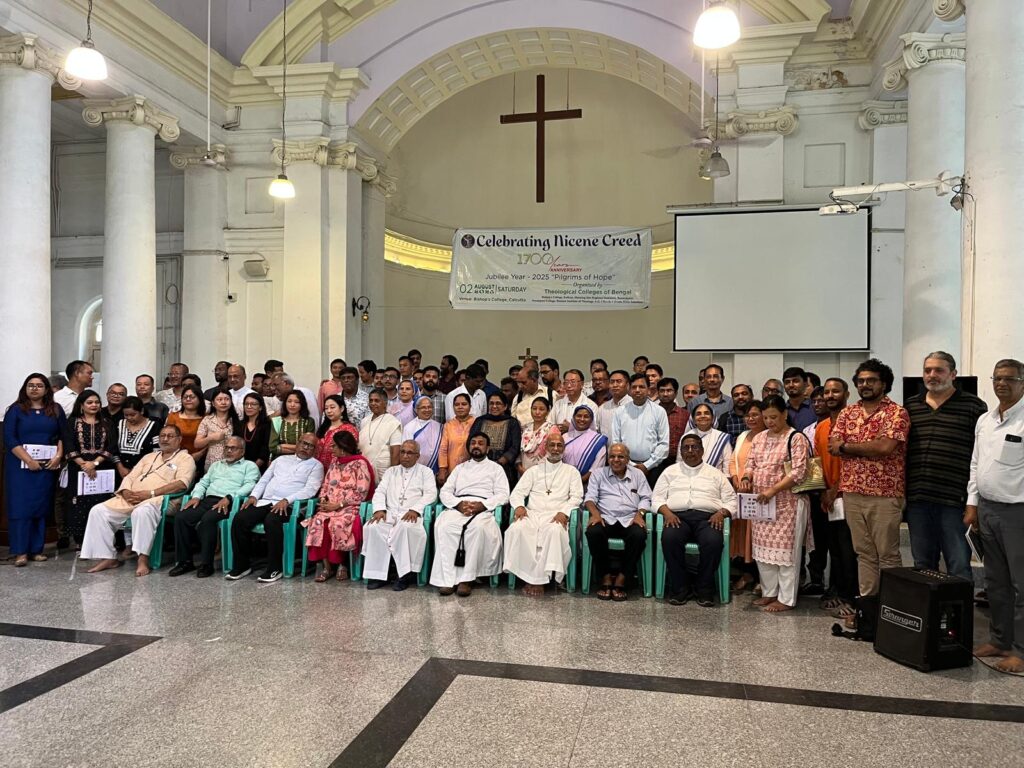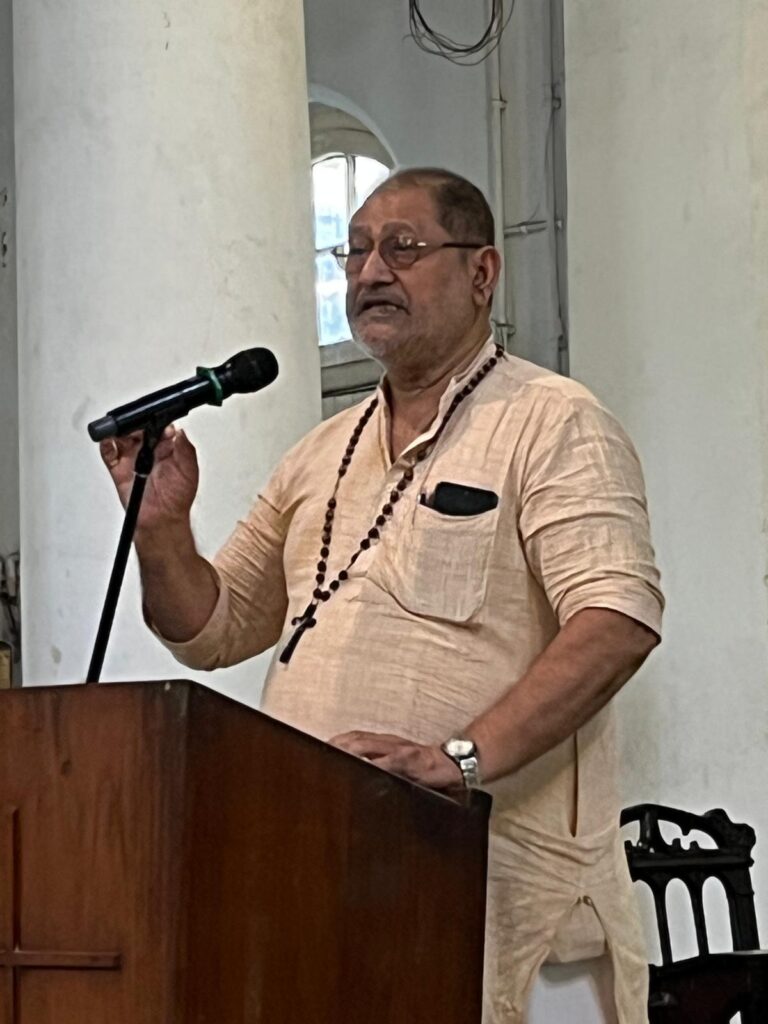(A presentation at Bishop’s College, Kolkata to commemorate 1700 years of the Nicean Creed, organised by the various Theological colleges of Bengal)

This paper has an audacious title, considering the oft repeated experience of St Augustine on the seashore, and bearing in mind that our present Pope Leo is a follower of that same spirituality.
To refresh one’s memory, St Augustine of Hippo was walking along the seashore while trying to fathom the mystery of the Most Holy Trinity. He came across a young boy trying to fill the ocean into a bucket. He reprimanded the boy for his foolishness. The boy retorted that “You are the real fool who is trying to comprehend the mighty Trinity in your small human mind”. This episode is used to state with finality that the Trinity is a mystery beyond human comprehension. I beg to differ.
What is the connection between the Nicene Creed of 325 and the Trinity today? Everything, because it is the greatest gift to Christian belief. This in turn was inexorably linked to who Jesus Christ was or is. It takes one back to the question that Jesus asked. “Who do you say that I am?” (Mat 16:15). Peter’s profession of faith echoes through time. “You are the Christ, the Son of the living God” (v 16). Had Christians fully comprehended the Petrine confession there would have been no need for the Council of Nicea!
I begin with extracts from three articles written by Michel Chambon in Union of Catholic Asian News (UCAN). The first focuses on the Trinity, the second on the non-Christian contribution to the Christian faith, and the third on the dangers of legalese. All three aspects are relevant to our reflection today. I quote as below:
- The Trinity: It is the heart of the Christian faith. There is a relational dynamic with the very being of God, an infinite mystery. Nothing in Christianity can overshadow the Trinity. The mystery of the Trinity still has much to teach us today
- Non-Christian impact: Constantine mobilised the imperial postal system and logistical apparatus to transport bishops from across the empire …The Council was not a purely Roman affair, bishops from outside the empire were also invited. Christians were divided; the impulse to unite them came from outside the community. Faith deepens through engagement with non-believers. Jesus too experienced transformation in his encounters with non-Jews. Atheist, Hindu or Muslim leaders can in fact help Christians to progress
- Legalese: The bishops issued 20 new canons the first expression of Canon Law. In the Christian world there is a need for regulation, but not for over regulation. Nicea reminds us that in a growing church rules are necessary. Rules were essential for fostering Christian unity. The Christian faith cannot be confined within a rigid framework of codes, prescriptions, prohibitions and laws. There is a certain vanity in legalism. Jesus clashed with the more legalistic Jewish movements. It is not easy to agree on the core principles that unite us. Sometimes we are tempted to give up trying. Some Christian communities have become excessively rigid, burdening their members with detailed rules, moral codes and constant oversight. This leads some to quietly walk away from what feels like totalitarian Christianity. Nicea promotes a dynamic relationship with the law … without entangling us in a rigid web of regulations
I have been asked to speak on the pastoral aspects of the Nicean Creed, even though it is essentially a dogmatic/ doctrinal formulation. I take the first point raised by Chambon – the beauty and centrality of the Most Holy Trinity. I squirm on my church bench every time a preacher refers to St Augustine on the seashore. By labelling something a mystery we are shying away from our responsibility to delve deeper to uncover the truth.
Before proceeding further I quote the relevant sentence from the Creed that fascinates me: “The Holy Spirit proceeds from the Father and the Son”. I am a family man, not a theologian, which is why I may have a slight advantage in understanding the Trinity, a gift of Nicea, now known as Iznik in Turkiye.
In simple terms the Trinity is a family of love. A couple finds fulfilment in the fruit of their love, their children. The Holy Spirit is the fruit (proceeding) or bond of love between the Father and the Son. Here is a set of cymbals (majeera). It has three parts, in a single entity. There is a cord that binds the two metal parts together, a symbol of the Holy Spirit proceeding from the Father and the Son, a bond of love.
Chambon said that our Christian faith is enriched by our interaction with non-Christians. I endorse that view. For exampleHinduism doesn’t have a hierarchy or a credo. There is freedom to believe in one God, several Gods or no God and still be a Hindu.
Here is my response. When people talk about the weather the urban dweller complains against the rain that fills the drains. The villager rejoices in the rain especially at this time of transplanting paddy. I ask my friends – what would happen if there were more than one god? One would order rain, the other not. It would be a clash of Titans, louder than any thunderclap or lightning bolt. The unity of nature and creation points to one God who lets the sun shine or rain fall on all, good or bad (cf Mat 5:45).
However, if God is one, how can it be Love? Loving itself would be selfishness. There has to be some one else to love! The Father loves the Son (Jn 3:35, 5:20, 10:17), and vice-versa and the Holy Spirit is the fruit of that love. In turn this creative, boundless love extends to all creation.
This explanation may sound simplistic. Prolific writer Rev R.H. Lesser said to me “A genius is one who can reduce great truths to simple understanding”. Jesus was a genius who never taught complex theology. Through parables he unravelled the mysteries of the Kingdom of God. Pope Francis of beloved memory often said that we should leave the theologians to their discussions (did he mean squabbles) while we get on with our pastoral ministry, reaching out to others in need.
This brings us to the second part of Chambon’s dissertation – on learning from non-Christians. Hinduism also has a concept of a triune godhead – Brahma (the creator), Vishnu (the protector) and Mahesh (the controller and guide). This comes close to our perception of the three persons of the Trinity – the Father (creator), Son (saviour) and Holy Spirit (the Paraclete that guides us on our way).
Another beautiful example is of Sachidananda. Sat stands for Truth, Chit for word and Anand for joy. This again blends so beautifully with the triune God – the Father is the eternal truth, the Son is the Word made flesh and the Holy Spirit is the source of our joy.
Another comparison with the Trinity can be found in the Transactional Analysis (TA) School of psychology. It is based on three states – Parent, Adult and Child. Here again they compare favourably with the Father (parent), Jesus (adult) and the Holy Spirit (child or fruit of love).
This mirror image is corroborated by two spiritual masters. St Gregory of Nyssa states, “When you hear that the divine mystery is exalted above the heavens … and its nature inaccessible, do not despair of ever beholding what you desire. It is indeed within yourselves, the standard by which to apprehend the divine”. St Catherine of Sienna further corroborates: “Our nature mirrors yours, as your nature mirrors ours because of the union affected in man when the eternal godhead was clothed in the wretched darkness and feeble substance of Adam’s flesh”.
To this I may now add the words of St Augustine: “Help me know thee, help me know me”. In a sense therefore self-realization (who we really are) is a big step towards God realization (experiencing the beauty and joy of the Most Holy Spirit).
Hence I conclude with my opening salvo that, far from being a mystery, the Most Holy Trinity, the gift of the Nicean Creed, is indeed within and all around us. May we continue to unravel this great truth.

Leave a Reply